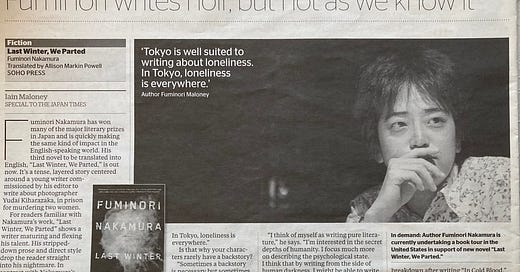I have an archive… no, archive is too grand a word. I have a stack of stuff I’ve kept over the years: newspapers, magazines, anything I’ve been published in, sitting in the spare room/office upstairs. I’m not usually one to keep stuff, not sentimental in that way, but some of this stuff mattered to me—the first story I have published, the first story about my writing in the paper, the first time I wrote for a paper—and some of it came when the internet was in its infancy, back when all this was just fields, and so it came with me from flat to flat, from Scotland to Japan. The other day I was sitting in the office looking at these stacks, files, boxes of stuff, and wondering what I was ever going to do with them. Well, this substack was originally envisioned as a kind of archive, a place to collect all the fallen leaves of my writing, and so by rights that stuff should be catalogued here too. So that’s what I’m going to do. Not regularly, but when I have something interesting to say about it, or a gap that needs filling.
The first thing I found is this interview in the Japan Times with Fuminori Nakamura. It was, I think, the first interview I ever did, and it was done entirely in Japanese by email. My language skills at the time were in no way up to the job, which is why it had to be done by email (gave me time to think and access to a dictionary). I also spoke to the translator, Allison Markin Powell, though none of that was used in the interview, and we’re still in touch today. She’s translated some amazing stuff, and keeps me up-to-date on what’s in the pipeline, in terms of Japanese literature.
I am still a big Nakamura fan. His brand of intelligent literary noir is right up my street, crime without the procedural, murder without the mystery. Nakamura is interested in what makes good people bad, and if there is such a thing as true evil. For a while there was a translation of his coming out every year but it has slowed down recently. Hopefully it won’t come to a complete stop as there is much more of his work to be translated and enjoyed.
I kept a physical copy of this because I didn’t know then that writing for the Japan Times would become a regular thing. I’ve now done hundreds of interviews and reviews for the paper, and they are all itemised on my main website, so I gave up on the idea of having a paper record pretty quickly, but opening the pages of the Sunday edition from November 2, 2014, I remember the rush of excitement seeing my first interview as a literary journalist in print, followed quickly by the disappointment of the mistake in the photo caption, where Nakamura is referred to as Fuminori Maloney. Not my doing, I hasten to add.
My writing for the Japan Times has pretty much ground to a halt. Space is being squeezed in the print edition and the managing directors don’t want anything on the website that isn’t in the print edition. Books are way down their list of priorities. It’s a real shame, but one replicated everywhere. Getting word out about new books is difficult, and outlets like the Japan Times were widely read and respected, so a mention there could do wonders for a book’s chances of survival. Besides, the taste for proper literary criticism is also dwindling with the rise of book vlogs and bookTok. People want personal reactions to books, they want plot synopsis, teasers, and why I love this book. They don’t want (it seems to me anyway) detailed discussions about influences, context, and legacy. They aren’t interested in examinations of structure, form, or narrative. At one point the JT book review column was down to 250 words. Once you’ve given a brief summary of the plot, you’re left with about 60 words in which to encapsulate why this book is worth devoting scarce column inches to… it’s infuriating.
Anyway, back in November 2014, that was all in the future. On that particular Sunday I was just delighted to see my name and writing in print in a respected newspaper.




